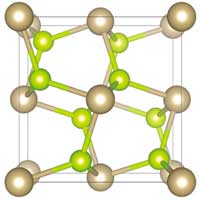| Nov 12, 2019 | |
New spin directions in pyrite an encouraging sign for future spintronics(Nanowerk News) Topological materials have exciting potential for next-generation, ultra-low energy electronics, including thermoelectric and spintronic devices. |
|
| However, a restriction on the use of such materials in spintronics has been that all topological materials studied thus far have spin states that lie parallel to the plane of the material, while many/most/all practical spintronic devices would require out-of-plane spin states. | |
| Generating and manipulating out-of-plane spins without applying an external electric or magnetic field has been a key challenge in spintronics. | |
 Crystal structure of Pyrite OsSe2/OsTe2 The new Monash Engineering study (NPJ Quantum Materials, "Selective control of surface spin current in topological pyrite-type OsX2 (X = Se, Te) crystals") demonstrates for the first time that pyrite-type crystals can host unconventional energy- and direction-dependent spin textures on the surface, with both in-plane and out-of-plane spin components, in sharp contrast to spin textures in conventional topological materials. “A number of pyrite-type materials have previously been theoretically predicted to show the desired out-of-plan spin textures,” explains lead author Dr Yuefeng Yin, in Monash Engineering’s Computational Materials Lab. Pyrite (colloquially known as fool’s gold) is an iron-sulfide mineral that displays multiple internal planes of electronic symmetry. ”The presence of strong local symmetry protects out-of-plan spin states,” explains Yuefeng, “so we decided to look closer at some of these crystals.” The study |
|
| Using first-principles calculations, the Monash team separated surface spin states by their interactions with spin states in the bulk of the material, resulting in highly anisotropic but tunable behaviour. | |
| As well as funding from the Australian Research Council (Centre of Excellence and ARC Laureates funding) the authors gratefully acknowledge computational support from the Monash Campus Cluster, NCI computational facility and Pawsey Supercomputing Facility. | |
The link between symmetry and topological materials |
|
| The presence of strong, local symmetry provides topological robustness to spin states, and symmetry is therefore a strong predictor of topological behaviour, so that studying these phenomena in pyrite crystals should provide clues towards discovery of many other new topological materials. | |
| Topological insulators are novel materials that behave as electrical insulators in their interior, but can carry a current along their edges. Unlike a conventional electrical path, such topological edge paths can carry electrical current with near-zero dissipation of energy, meaning that topological transistors can switch without burning energy. | |
| Topological materials are investigated within FLEET’s Research theme 1, seeking ultra-low resistance electronic paths with which to create a new generation of ultra-low energy electronics. |
| Source: FLEET | |
|
Subscribe to a free copy of one of our daily Nanowerk Newsletter Email Digests with a compilation of all of the day's news. |
